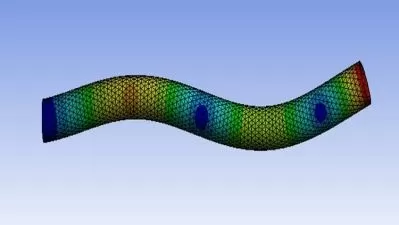Ansys - Finite Element Analysis and Industrial Applications
Burak BALLI
24:03:33
Description
Linear Static Analysis with Finite Element Method
What You'll Learn?
- Fundamentals of Ansys Workbench
- Defining Materials
- Creating and Importing Geometry
- Creating Parameters and Discussing the Effects of Parameters to Analysis.
- Optimization Based On Parameters
- Topology Optimization and Reducing Weight
- Meshing in Details
- Boundary Conditions (Loads and Supports)
- Contact and Joint Types
- Static Structural Section in Details
- Structural Analysis
- Hydrostatic Analysis
- Connection Equipment Analysis
- Static Linear Analysis
- SpaceClaim
- Simplifying the Geometry in SpaceClaim
- Preparing the Geometry for Meshing and Contact Surfaces in SpaceClaim
- Meshing in Advanced Level
- Mesh Tips and Tricks in Advanced Level
- Contacts in Advanced Level
- Creating Submodel
- Industrial Applications
Who is this for?
What You Need to Know?
More details
Description--- Check My Website (importfea) ---
We are going to make a detailed examination of linear static analysis in the tutorial. After learning the necessary fundamentals, we will focus on the static structural section. In the static structural section, we'll see all of the loads, supports, contacts, joints, and mesh types with applications.
Versions 19.2, 19.3, and 2020R2 were used in the tutorial. For more detailed information and surprises, don't forget to visit my Instagram page (@ansysegitim) :)
We can gather the tutorial under 2 topics as introductory and advanced tutorials. We will be learning the topics below for the introductory course.
Before reviewing these topics, I need to make it clear to you. First of all, let's talk about what the tutorial does not include :)
I did not include the non-linear analysis at this stage, since the topic is advanced. You are not going to see crashed trucks, plate-piercing bullets, flying aircraft, rockets, tanks or rifles, etc in the tutorial. All of these need separate courses. For this reason, learning them as a beginner in 10 minutes, 30 minutes, or 1-hour courses only teaches you to make colorful animations of that truck or plane :) The topics require mastery separately.
Now, let's examine what awaits us in the course.
In the introduction part, my aim is to teach to use the Ansys. Each of the lessons is created with the aim of learning one specific topic within Ansys and is focused on that purpose. For example, if we are trying to learn the topic of boundary conditions, then we don't struggle to get fine mesh quality or structures or we don't need to prepare the model for meshing while we are learning the topic of contacts.
You will get a better understanding of the applications after the theoretical lessons.
In the tutorial, we will not only go to the analysis results with a few mouse clicks, we will reach the results by explaining which option we used and why we used it. Thus, after a while, you will be able to make many applications yourself.
I have also covered in detail topology optimization (weight reduction) which is indispensable for design.
I have also covered the topic of optimization. You will learn how to keep stresses below your desired value while improving the design by creating parameters.
I have included in detail truss systems and structural analysis which are indispensable for static analysis.
You will learn how to analyze fasteners especially bolted connections.
I also added many more topics and applications related to static analysis to the first section of the tutorial
In the second section, the advanced sections, we will be examining the following topics.
Firstly, I wanted to make a reminder by going back to the fundamentals of engineering concepts from the very beginning. The fundamentals are topics that we must know and even develop. Under the title of fundamentals of engineering, you will see the topics of Stress, Strain, Young's modulus, Poisson's Ratio, and some important Material Properties.
I explained all the commands separately that we will use frequently while preparing the geometries on SpaceClaim. We will discuss how to prepare a geometry/model, what should we pay attention to while preparing a geometry, what we should simplify, what should we keep in the geometry, and how to prepare geometry for meshing.
I tried to explain the topic of advanced mesh in great detail from the scratch in advanced level mesh lessons. I started by teaching the mesh element types, the element orders, the effect of element types on the results, how to find the optimized element size, and how to make a mesh convergence study. I also gave you the tips that FEA Experts frequently use to obtain fine mesh structures. I suggest you definitely don't miss this part.
Under the title of advanced contact, we discussed the questions of what we should pay attention to while creating contact regions, which contact type is decent for which structures and what sub-settings come out while creating contact regions, how does it affect the results, when to use it and when to ignore it.
We examined the topic of submodeling which is indispensable for an analysis. You will learn how to create a submodel and what you should pay attention to while creating them.
And the final and great topic is the Industrial Applications. You should definitely not miss it. You will see some real-world engineering problems that I have run the analysis as a structural analysis engineer. We examined these projects in detail and examined how we solved them from the very beginning to the very end of the analysis (The dimensions of the projects were changed and some changes were made to ensure that they were not exactly the same but you will get the main idea).
Goodbye for now...
Who this course is for:
- Studens in Engineering
- Everyone who wants to learn FEA or Ansys
--- Check My Website (importfea) ---
We are going to make a detailed examination of linear static analysis in the tutorial. After learning the necessary fundamentals, we will focus on the static structural section. In the static structural section, we'll see all of the loads, supports, contacts, joints, and mesh types with applications.
Versions 19.2, 19.3, and 2020R2 were used in the tutorial. For more detailed information and surprises, don't forget to visit my Instagram page (@ansysegitim) :)
We can gather the tutorial under 2 topics as introductory and advanced tutorials. We will be learning the topics below for the introductory course.
Before reviewing these topics, I need to make it clear to you. First of all, let's talk about what the tutorial does not include :)
I did not include the non-linear analysis at this stage, since the topic is advanced. You are not going to see crashed trucks, plate-piercing bullets, flying aircraft, rockets, tanks or rifles, etc in the tutorial. All of these need separate courses. For this reason, learning them as a beginner in 10 minutes, 30 minutes, or 1-hour courses only teaches you to make colorful animations of that truck or plane :) The topics require mastery separately.
Now, let's examine what awaits us in the course.
In the introduction part, my aim is to teach to use the Ansys. Each of the lessons is created with the aim of learning one specific topic within Ansys and is focused on that purpose. For example, if we are trying to learn the topic of boundary conditions, then we don't struggle to get fine mesh quality or structures or we don't need to prepare the model for meshing while we are learning the topic of contacts.
You will get a better understanding of the applications after the theoretical lessons.
In the tutorial, we will not only go to the analysis results with a few mouse clicks, we will reach the results by explaining which option we used and why we used it. Thus, after a while, you will be able to make many applications yourself.
I have also covered in detail topology optimization (weight reduction) which is indispensable for design.
I have also covered the topic of optimization. You will learn how to keep stresses below your desired value while improving the design by creating parameters.
I have included in detail truss systems and structural analysis which are indispensable for static analysis.
You will learn how to analyze fasteners especially bolted connections.
I also added many more topics and applications related to static analysis to the first section of the tutorial
In the second section, the advanced sections, we will be examining the following topics.
Firstly, I wanted to make a reminder by going back to the fundamentals of engineering concepts from the very beginning. The fundamentals are topics that we must know and even develop. Under the title of fundamentals of engineering, you will see the topics of Stress, Strain, Young's modulus, Poisson's Ratio, and some important Material Properties.
I explained all the commands separately that we will use frequently while preparing the geometries on SpaceClaim. We will discuss how to prepare a geometry/model, what should we pay attention to while preparing a geometry, what we should simplify, what should we keep in the geometry, and how to prepare geometry for meshing.
I tried to explain the topic of advanced mesh in great detail from the scratch in advanced level mesh lessons. I started by teaching the mesh element types, the element orders, the effect of element types on the results, how to find the optimized element size, and how to make a mesh convergence study. I also gave you the tips that FEA Experts frequently use to obtain fine mesh structures. I suggest you definitely don't miss this part.
Under the title of advanced contact, we discussed the questions of what we should pay attention to while creating contact regions, which contact type is decent for which structures and what sub-settings come out while creating contact regions, how does it affect the results, when to use it and when to ignore it.
We examined the topic of submodeling which is indispensable for an analysis. You will learn how to create a submodel and what you should pay attention to while creating them.
And the final and great topic is the Industrial Applications. You should definitely not miss it. You will see some real-world engineering problems that I have run the analysis as a structural analysis engineer. We examined these projects in detail and examined how we solved them from the very beginning to the very end of the analysis (The dimensions of the projects were changed and some changes were made to ensure that they were not exactly the same but you will get the main idea).
Goodbye for now...
Who this course is for:
- Studens in Engineering
- Everyone who wants to learn FEA or Ansys
User Reviews
Rating
Burak BALLI
Instructor's Courses
Udemy
View courses Udemy- language english
- Training sessions 86
- duration 24:03:33
- Release Date 2024/02/25










